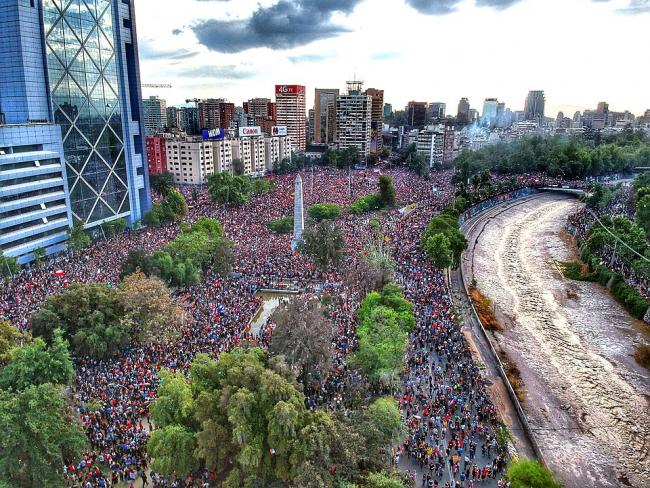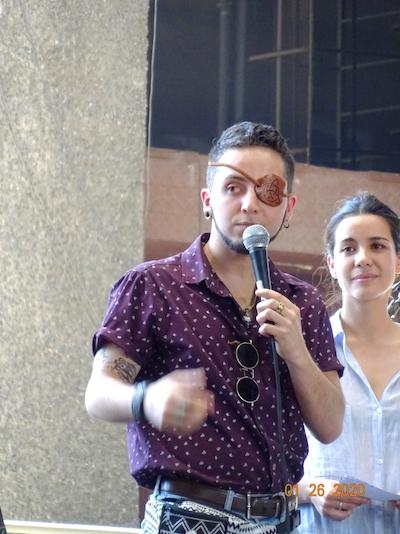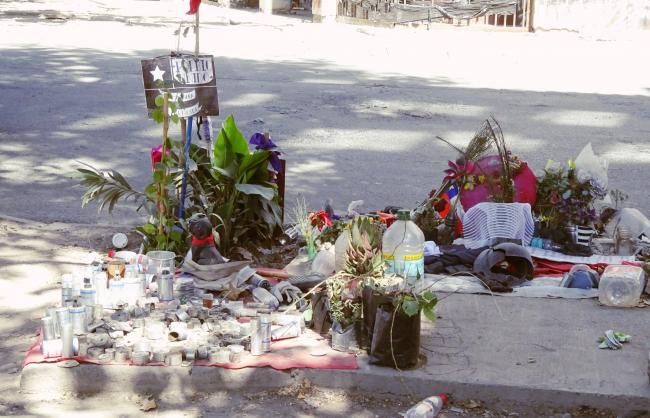
On March 14, NACLA will be celebrating its 50-year history with a special gala fundraiser in New York City. Tickets are now on sale. Click here for more information.
The social uprising in Chile has now reached its fourth month. Masses of people continue to protest and demand structural change despite ferocious repression—mainly at the hands of the militarized Carabineros police force—which has revived traumatic memories. Now, Chileans are looking ahead to a plebiscite that may open the way to a new Constitution. The dictatorship-era charter has been a major obstacle to change over the past three decades. Redrafting the constitution is a key demand in Chileans’ sweeping rebuke of the status quo.
General Augusto Pinochet’s 1980 Constitution both symbolizes and imposes the authoritarian model at the root of the ongoing mobilization. The Constitution institutionalized the economic and political domination of the dictatorship and enshrined a neoliberal framework that erased the role of the state in social and economic areas. It restricted political participation, gave the Right disproportionate power, and installed a tutelary role for the armed forces. And it continues to straightjacket the Chilean system. I, among others, analyzed such regimes in the 1990s—I termed them “guardian systems.”
Despite 30 years of post-dictatorship elected rule and some reforms to the 1980 Constitution, the market model embodied in Pinochet’s charter still shapes economics and politics in the country. Pinochet’s radical neoliberal transformation privatized the pension system and promoted the development of a private sector in the health and education fields. These privatizations have perpetuated inequality and reinforced extreme social divisions. Moreover, Chile is the only country in the world with almost completely privatized water—Chapter III, Clause 24 of the 1980 Constitution establishes the “right” to private ownership of water. Drought paired with the corporate monopolization of water resources concessioned to the mining and agriculture industries have caused multiple communities, small farms, and cities in various parts of the country to run dry in the past year. The Constitution locked in these “guardian structures” by imposing strict rules for constitutional amendments, requiring supermajorities in Congress.
Chile’s elected governments have not reformed or democratized the Carabineros since the dictatorship, and the militarized police continue to treat the Chilean people as “the internal enemy.” Shortly after the protests began in October, president Sebastián Piñera, a right-wing billionaire, declared while surrounded by military officers: “We are at war.” He called thousands of army troops to patrol the streets for the first time since the dictatorship, to enforce a 10-day curfew, evoking memories of Pinochet’s terror. Piñera’s government, whose support has vacillated between 4 to 7 percent in 2020, has used repression to sow fear, intimidate, and attempt to divide protesters. But outrage over the October crackdown only spurred more massive demonstrations. On October 25, 1.2 million chilenos gathered to protest in Santiago’s Plaza Italia. “¡Chile despertó!” they chanted. “Chile woke up.”
Since then, several international human rights delegations have criticized the security forces, denouncing the deliberate intent to inflict harm on the protesters rather than disperse them. In November 2019, Human Rights Watch noted “compelling evidence of excessive use of force and abuses against demonstrators and bystanders.” Chileans are struggling against the repression of the state as well as the unjust economic system. They are demanding rights for the people as opposed to private profit-making.
Inequality in Chile
The October protests put Chile’s entrenched inequality in the spotlight. A 2019 study by The Lancet showed that a woman in a poor district of Santiago lives some 18 years less than a woman in a rich neighborhood in the same city. Chile’s income inequality gap is more than 65 percent wider than the OECD average, and it has one of the highest ratios between the average income of the wealthiest and poorest 10 percent of the population, according to a 2018 report. The neoliberal gutting of public services has fueled rampant inequality. The country has two health systems: an excellent private system for those who can pay First World fees, and a severely underfunded public system serving some 80 percent of Chileans. Wait times in public hospitals can last for years and there are insufficient supplies. Almost 10,000 persons died in the first half of 2018 while waiting for an operation or treatment in the public system.
The privatized pension system, which has produced a bonanza of wealth for its investors, pays a pittance to elderly people who worked their whole lives. According to a 2015 report by La Comisión Asesora Presidencial sobre el Sistema de Pensiones, 80 percent of retirees receive less than the minimum wage of $414 per month in pensions. The educational system reproduces class divisions, as youths from the upper classes easily enter prestigious universities, while those from modest backgrounds come from substandard schools. University education—considered a market commodity and not a right or a public good—is expensive, and families go into debt for years to pay. Salaries are low and the cost of living continues to increase. The metro fare hike that sparked the social uprising in October was the last straw. As the protesters chanted, “It’s not 30 pesos, it’s 30 years!”
Chile’s Social Rebellion
While continuing Chile’s rich history of popular resistance, the demonstrations since October also mark a new era of social struggle defined by broad-based participation, youth involvement, and new forms and symbols of autonomous mobilization. “María,” (not her real name), who has attended all the Friday protests as well as others, explained that since October, the Carabineros, with their tanks and squadrons, have blocked the avenues where people have traditionally marched. María, a young professional and social science graduate, pointed out that that the strategy produces large concentrations of people in the plazas. The primera linea—youths who wear bandanas and carry homemade shields—ring the crowd to protect them from bullets, gas canisters, and advances by the Carabineros. Meanwhile, popular symbols have changed. In large demonstrations in the past, people carried the banners of their political parties or social organizations. Such banners are gone in the protests today, reflecting the spontaneous nature of the social explosion and its distance from the political parties. Today people carry Chilean flags, Mapuche flags, or black flags condemning state violence. More surprising are the banners denoting allegiance to particular fútbol teams, such as Colo-Colo, which is something new. The protests grow in size whenever there is a new outrage.
Chileans are demanding an end to socioeconomic and political exclusion. Some 70 to 80 percent are in favor of a new Constitution—forged under democracy—to guarantee social rights. Chileans now look forward to the national plebiscite called for April 26 to vote for a path toward a Constitution that will protect the rights to education, health, and decent pensions, among others. The Piñera government initially resisted the idea of a plebiscite, but reluctantly acquiesced after political parties in Congress signed an agreement in November 2019 to move toward a solution to the massive unrest.
The plebiscite will ask voters two questions: whether or not they want a new Constitution, and whether they want the constitutional convention that would draft it to be made up of citizens or a mixed body of citizens and legislators. The convention would draft a new Constitution to be ratified in another national plebiscite.
The constituent process had to be approved by Congress and parliamentarians have a key role in legislating the mechanisms needed for the constitutional process. The Left has pushed for the constituent convention to have gender parity and to reserve seats for independent social activists, not only political party members, as well as Mapuche representatives, but these measures have not yet succeeded in Congress. In the Senate, 3/5 approval was necessary to approve gender parity; although outvoted, the right-wing minority had enough votes in January to block the measure. The extreme Right is already lobbying against the new Constitution. In particular, members of the Unión Demócrata Independiente (UDI), founded by Pinochet functionaries, prefer authoritarian options to preserve their wealth and power. Some sectors of the extreme Right want to annul the plebiscite entirely, arguing that there is too much violence for the process to take place.
Meanwhile, the government has made its position clear. On December 16, when a television journalist asked whether he would contemplate a new model as people were demanding, Piñera— a key proponent of Trump’s campaign to oust Venezuela’s Nicolás Maduro—retorted: “If you speak of a change in the model you’re thinking of Venezuela!” On February 2, the minister of education, Marcela Cubillos, declared that she was not “neutral” on the constitutional process, stating that “the government represents a project of society whose fundamental values are expressed in the current Constitution.” Cubillos, a UDI member, is known for her repressive reactions to protests, her intransigence, and her hostile attitude toward educational reform. Her father was a navy officer, an organizer of the 1973 coup, and Pinochet’s minister of foreign relations for two years.
Carabinero Repression
The casualties suffered by the social movement have been the worst since the dictatorship. The Carabineros use aggressive and unprovoked violence against demonstrators and onlookers, deploying tanks to spew toxic gases in large crowds and shooting tear gas canisters and rifles directly at protesters. Piñera has praised the force, while its commander, General Rozas, has stayed in the shadows. Indeed, the government has refused to remove him, despite repeated requests by political party leaders and social activists. Five human rights reports—authored by Amnesty International, Human Rights Watch, the Office of the UN High Commissioner for Human Rights (OHCHR), among others—have denounced the brutal and indiscriminate violence of the militarized police. Some 36 people have died, though exact tolls vary. The OHCHR reported that 28,000 people were jailed between October 18 and December 6, many arbitrarily. In a January 31 report, the Instituto Nacional de Derechos Humanos (INDH) noted that 427 persons had suffered mutilations of their eyes due to state violence. Some people have completely lost one or both eyes.

Rights groups have documented how the Carabineros have aimed teargas canisters and rifles at people’s heads, against their own protocols. Police rifles were supposedly equipped with rubber bullets, but the University of Chile discovered police were firing shotgun pellets, with only a small proportion of rubber. The OHCHR, in its December 2019 report, decried “torture, ill-treatment, rape and other forms of sexual violence” against those detained by the Carabineros and denounced the “unnecessary and disproportionate use of less-lethal weapons, in particular anti-riot shotguns, during peaceful demonstrations and/or outside the context of violent confrontations between demonstrators and security forces.” Videos circulated on social media show the Carabineros have used their vehicles to hit and crush people. They also have attacked medics, press people, and human rights observers with clearly marked signs and uniforms.

On January 28, as fans were leaving a stadium in Santiago after a soccer game, a Carabinero truck traveling at high velocity hit a fan named Jorge Mora and kept driving. The incident was caught on video and went viral on social media, provoking enormous protests. Mora died before reaching the hospital. The same night, Piñera, said in an event, “When the Carabineros go out on the street they do so to protect public order.” The Carabinero driving the truck was detained, but the next day a court freed him and told him to sign in once a week at the police station. This ruling provoked even more outrage.
Hundreds of beatings of civilians, especially by groups of Carabineros, have been concentrated in Santiago Centro and in Puente Alto, singling out this working-class barrio in the southern part of the city. The INDH documented a total of 697 cases of squads of state agents attacking and beating lone civilians between the start of the uprising and January 31, including 123 incidents involving Carabineros, nine involving military men, and seven involving the investigative police. One notorious incident took place on January 29, when, after a protest over Jorge Mora’s death, seven or eight Carabineros attacked and savagely beat an18-year-old named Matías Soto. They left the youth on the sidewalk, with multiple fractures, jumped back into their van, and drove off. A security camera captured the entire assault. The INDH filed a lawsuit for torture in this case.
In addition to the police brutality, beloved symbols of popular culture have also suffered damage. The tomb of New Song folksinger Víctor Jara, who was tortured and murdered in 1973, was vandalized on January 18. The Víctor Jara Foundation organized a ceremony to clean and beautify the tomb, gathering musicians and the general public in the cemetery to dispel the aura of hatred. The Centro Arte Alameda, an arts center dating from 1992 near Plaza Italia, was burned and heavily damaged due to a fire in December. The center had provided space to medical personnel and people wounded in the demonstrations. While the fire is still under investigation, witnesses said Carabinero canisters started the blaze and videos seemed to verify that. On February 7, the Violeta Parra Museum, dedicated to the national artist and singer-songwriter, was burned after the Carabineros fired at least six flaming tear gas canisters at the building. Videos posted on Twitter as well as eyewitnesses documented this case.
The Protests Continue
Despite the repression, Chileans continue to demonstrate almost every day, and large protests continue each Friday in Plaza Italia, popularly renamed Plaza de la Dignidad. The Carabineros mobilize in force on Fridays, and incidents invariably occur. The composition of the crowds has changed since the early days, when hundreds of thousands of people of all ages went to the plaza. Today, most of the demonstrators are young. They don gasmasks and bandanas, and some have begun fighting back when cornered by Carabineros. Some Carabineros have been injured, although statistics vary widely.
The Chilean people are determined, they are creative, and they are resilient. Protesters have worked with firefighters to put out fires started by tear gas canisters. Thousands of fans at soccer games have held up huge banners, denouncing the repression and chanting against Piñera. Bike riders have staged mass group rides to protest. People chant against the government in traditional festivals and carnivals. Popular musicians have played in large concerts and benefits to help victims of the violence, especially those who have lost eyes. Hundreds of women have performed the spoken feminist anthem “El violador eres tú” by Las Tésis, which has also been replicated around the world in different languages. Singers such as Nano Stern and Ana Tijoux have written songs about the rebellion and the state’s violence, while people continue to sing other songs, including the iconic, politically conscious music of Víctor Jara and Los Prisioneros. National poet Raúl Zurita wrote an anguished poem called “Venceremos” about the hundreds of eye injuries, which captures the solidarity of the Chileans with the words:
And we will embrace each other weeping
And we will embrace each other singing
And my eyes will be your eyes
And all Chile will be your eyes…
Popular street murals, along with graffiti, cover the walls of central Santiago, and makeshift memorials and flowers mark the places where people died. Protesters carry a giant plaster statue of the “revolutionary dog” El Negro Matapacos—a street dog who accompanied students during the 2011 protests, and other later ones—along with other puppets, and some demonstrators dress as aliens or cartoon characters such as Pikachu.

Piñera has made small concessions but has resisted any structural change to the neoliberal model. His response to social demands has been repression rather than dialogue. Piñera and his allies have pushed to enact a “security agenda” which has had some success in Congress. In January, Congress passed an “anti-looting law” that criminalized various protest tactics such as building barricades, blocking traffic, and wearing bandanas. The law is now in effect. The Office of the UN High Commissioner for Human Rights had expressed alarm in a letter to Congress, stating: “Some of the legislative initiatives risk harming the exercise of a series of human rights, particularly…freedom of peaceful assembly, freedom of expression…”
The Plebiscite and the Future of Chile
Will the people of Chile be able to shape their own destiny via a plebiscite? Two months before the scheduled vote, the answer remains uncertain. Approval ratings of Chile’s institutions, including the Congress and the president’s office, rank at an all-time low in surveys. María, the protester, expressed her greatest hope for this process: “We want an end to this neoliberal system with its injustices and its inequalities, so people can live with more fairness and more dignity,” she said. “We want to end the Constitution of Pinochet and to move toward a state with social justice.” Her greatest fear? “That nothing will change.”
The month of March will be definitive in this struggle. Schools begin again and Chileans return to daily life. Chileans are very clear that they want a new political and socioeconomic model that assures their rights. Their struggle to transform the state has implications for all of Latin America, and indeed, for the world. Chile represents the hope that “people power” can overcome extreme versions of neoliberalism and restricted forms of politics to achieve new, more democratic systems of governance.

J. Patrice McSherry is a researcher collaborating with the Institute of Advanced Studies (IDEA) of the University of Santiago, Chile, and professor emerita of Long Island University. Her most recent book is book is Chilean New Song: The Political Power of Music, 1960s-1973 (2015). She thanks professors Raúl Molina and Rose Muzio for their comments on the article.

